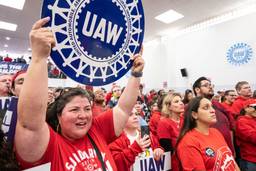
Resident physicians work long, grueling hours as they finish their medical training. Eighty hours a week or more is typical. During that time, under the supervision of an attending physician, they have major responsibilities — making medical decisions, treating patients and performing surgeries.
Much of their work is done independent of their supervisors, notes John Paul Graff, a second-year resident at the University of California, Irvine. “You’ve got one internal medicine attending and probably seven residents that are working. That one attending, they’re not seeing every single patient, doing every single chart dictation. There’s seven residents who are delegated to that.”
For that, the residents are typically paid $40,000 to $50,000 a year.
Hospitals get a great deal: Residents are required to do between three and six years of training depending on their speciality, and while they’re doing that training, they’re a lot cheaper than a hospitalist, who might make $200,000. And the promise of that future fat salary keeps residents hustling through these broke, overworked years.
It’s a recipe for exhaustion and exploitation that led Graff and his colleagues to think a union could help. He sees the union as an opportunity for residents to speak to each other, compare problems, and negotiate with the hospital over common issues rather than struggling alone.
The Committee of Interns and Residents at SEIU already represents more than 13,000 medical residents across the country. But two hospital systems — UC Irvine and, across the country, the Mount Sinai Health System in New York — are fighting the unionization effort, arguing that residents aren’t really workers. UC Irvine has specifically argued that interns (first year residents) are still students, despite the fact that they receive salaries and benefits, perform many procedures with “indirect supervision” – meaning the attending physician need only be somewhere in the same facility – and work up to 16-hour- long shifts. The university has also argued that doctors on rotation and on fellowships shouldn’t be allowed to join the union, submitting in a court brief (provided to In These Times by CIR) that fellows “do not share a community of interest” with other residents because they are in a different training program, and that rotation disqualifies a resident as an employee of UC Irvine because she does some of her residency at an affiliated hospital that is not directly part of the UC system. Similar arguments have been made by the administration at Elmhurst hospital — a city hospital whose residency program is run through the Mount Sinai School of Medicine — though official court briefs are not available yet.
“There’s no way I’m still a student under any circumstance,” a resident in pediatrics at Elmhurst Hospital Center in Queens, N.Y. who wished to remain anonymous out of fear of retaliation from administrators, tells In These Times. “The way they explain it to us, we are like a hybrid: not really a student but not a full doctor, because they say that everything we do has to be signed off by our attending. I feel like that’s the same at any other job — that’s why you have managers, to supervise the work. We have a lot of autonomy. Of course I have to report to my supervisor, but at the same time we work independently.”
Residents also note that in addition to the core duties they perform, a Supreme Court decision held that they are indeed employees responsible for paying Social Security taxes.
The struggle to unionize
The UC Irvine residents filed for union recognition as an independent union in 2011, and voted to affiliate with CIR in June of this year. Some 600 workers would be represented, including fellows, residents at multiple levels of pay and experience, and doctors on rotation who work at several different hospitals while they complete their program.
But the hospital has challenged it, and the case is now before California’s Public Employment Relations Board. The ruling could come sometime this month, and if it overturns previous decisions about the employment status of residents, could impact other public sector physicians in the state.
The union expects that UC Irvine will appeal if they lose. If the university can delay the process for long enough, several of the residents who’ve been leaders in the organizing campaign may graduate, taking the wind out of the campaign’s sails.
To Graff, the whole battle solidifies his feeling that the hospital administration doesn’t want to have to speak to residents at all, but would prefer to talk to attendings, who then “corral” the residents. “There’s a lack of communication between the resident level and the administrative level. It’s being buffered by the attendings, in that military-esque ‘you report to your senior officer and they report to their senior officer’ kind of thing.”
The residents note that they contribute to the hospital’s profit — they’re subsidized by the state and bring in about $100,000 per resident in funding.
In New York, meanwhile, residents have been organizing in the middle of a large merger of two major hospital chains: Continuum Health Partners and Mount Sinai Health Systems, which are combining to form one of the country’s largest not-for-profit health systems.
At Elmhurst Hospital Center, residents have filed for union recognition only to be told, too, by Mount Sinai that they aren’t really workers. Residents at Elmhurst believe they’re being made an example of in order to prevent other residents in the system from filing. Residents at Beth Israel hospital, another part of the megachain, may file soon as well, and campaigns are underway in other Mount Sinai hospitals.
The Elmhurst residents say that they are facing “captive audience” meetings where higher-ups argue against the union and that leaders have been pulled aside by administrators who alternately threaten and cajole them to stop organizing.
“I was not expecting the reaction of the administrative people from Mount Sinai,” says the Elmhurst resident who spoke with In These Times. “I was not expecting that there would be a court case where they claim that we’re legally not allowed to become part of a union. I feel like if everybody’s honest, it’s all about money. But the language that’s being used becomes more and more legal and threatening, and that’s kind of what I find intimidating.”
Mergers like the one at Mount Sinai are becoming more and more common these days, as the healthcare system has changed. Healthcare costs have skyrocketed, and hospitals tend to want the patients with good insurance who can pay for high-end services. Those same well-off patients tend to be the ones who can see primary care physicians for preventive care, while on the other end of the scale, Medicaid patients and the uninsured end up going without treatment for minor illnesses and wind up in the emergency room for expensive treatments when they’re unable to hold out any longer – expensive treatments for which the hospital makes less money. The Affordable Care Act should theoretically provide more people with insurance, but it also expands Medicaid, which pays hospitals less and so won’t really solve this problem. So on the one hand, we see big hospital chains buying up other hospital chains, creating larger bureaucracies that leave their employees with even less power to make decisions or make changes in their workplace. And on the other, as I’ve reported, staff at community hospitals like Brooklyn’s Long Island College Hospital struggle to keep their facilities open. On both sides, the people who provide frontline care and know patients’ needs are left out of decision-making.
Graff thinks that unionizing could help physicians continue to have a voice in a system of mega-mergers and shutdowns. ”I think it’s going to become more common and more acceptable,” Graff says. “The physicians that work at these [megachain] hospitals, they’re no longer individuals, they become a number. When you become a number, you need other numbers with you if you’re going to speak up. Administrators don’t know who Dr. Tran is; they don’t know who Dr. Smith is. They just know he’s another guy who works in internal medicine or pathology or surgery. But if all the physicians come together and say. ‘Hey this is a big problem,’ they’re more apt to listen to you.”
Meanwhile, the ACA places more requirements on non-profit hospitals, which need to meet certain benchmarks for care. Residents, who provide much of that care, will be an important part of meeting those benchmarks, and if they’re squeezed for more work while being shut out of the decision-making process, it’s unlikely their work will improve.
Pressure to care
Healthcare workers, who are held to a standard of selfless care, face a particular form of pushback when they make demands for themselves. Administrators often say that asking for shorter hours or better pay shortchanges patients, who are the reason healthcare workers went into the field in the first place. Yet overworked, stressed doctors can’t be good for patient care either. Several studies published since 2004 have found that “schedules built on a foundation of 24-hour shifts have been found to increase the risk of provider occupational injuries as well as serious medical errors and patient injuries.” In the New York Times in April, physician Pauline Chen argued that even with shortened working hours, residents are overworked, expected to cover more work in those fewer hours.
In the case of residents, there’s also a hierarchical physician culture to confront, as Graff points out. Their careers are tied to completing their residencies. Being able to switch jobs isn’t really an option after they’re accepted into a competitive program – they can’t just pick up and leave before they finish. Many fear that complaints will make them seem lazy or clueless to the supervisors, both attending physicians and administrators, who can make or break their careers.
“People at the administrative level might not have ever worked on the floor in a hospital, they might just be MBAs and lawyers and finance people,” Graff says. “They don’t understand what that 12-hour shift looks like, or even that sixteenth or twenty-fourth hours of shift work is like, where you’re meeting the twentieth patient of that 24-hour time period and god you’re tired, you are exhausted, and you know if you need something, if you wanted to get a Coke or a coffee or some breakfast or something like that, it’d be really nice if that was made accessible to you in an easier way. That’s the simple little granular stuff that just doesn’t get carried up to the top administrative level.”
It’s the little things like that, rather than more salary increases or fewer hours, that could mean the most, the residents say, yet are hardest to negotiate on an individual level — especially with the amount of hours they are putting in.
Yet money is a concern for residents as well. Graff notes that the biggest difference between residents today and those of past generations is the massive student debt they incur on the way to being able to practice. For his father, also a physician, residency was simply “an initiation ceremony” – you work really hard for a couple of years and then you come out and make good money for the rest of your career.
But now, he says, residents face financial pressure from both sides. First, hospitals rely more on smaller payments from Medicare and Medicaid and face huge pressure to cut costs, which leaves them relying on the cheaper residents to provide more care – and those residents face the pressures workers do everywhere, to “do more with less.” Also, as the cost of college has increased, many of the residents coming in are saddled with some $200,000 in debt.
“Your goal as a resident is trying to keep that under control so that when you graduate from residency, that $200,000 hasn’t morphed into $400,000,” says Graff. “Everybody has this mentality that as soon as they get out of residency it’s going to take them at least a decade to pay back their loans. That imparts a huge level of fear and stress onto all residents. Just like anybody else who goes to work every day, there’s always a risk: What if I get fired and I can’t support my family, can’t pay my car bill, can’t afford my apartment? We have all these things, and then plus we have this enormous debt, and it’s not for a house, it’s not for a boat, it’s not for a car, it’s for our own education and the only way to pay [it] back is to get a job that utilizes in some way the education that you [paid for].”
A little bit of extra money here or there — help with parking fees, gas stipends for residents on rotation at other hospitals, a bit of help with housing or moving funds — would do a lot not only to ease the financial burden for the rough years, but also make residents feel cared for and make it easier for them to do their jobs, he says.
Being part of CIR/SEIU has helped residents at other hospitals deal with scheduling conflicts and family leave policies, and the union has also pushed for laws that limit the amount of hours a resident can work (one exists in New York).
As they wait for decisions to come down on their right to be recognized as workers in the hospital, the Elmhurst resident notes that what a union could really do is create a stable system of communication for residents whose time is necessarily limited — both while they’re on the job working arduous schedules, and in the amount of time they spend in their program. Creating a system by which residents can communicate with administrators over their problems and ideas seems like a win-win for everyone, he notes, even the hospital. To him, professionalism isn’t a reason not to join a union — it’s the reason he wants one.
He says, “It’s possible to sit at a table and negotiate without it being a conflict because we’re all professionals and we should act like professionals.”

I hope you found this article important. Before you leave, I want to ask you to consider supporting our work with a donation. In These Times needs readers like you to help sustain our mission. We don’t depend on—or want—corporate advertising or deep-pocketed billionaires to fund our journalism. We’re supported by you, the reader, so we can focus on covering the issues that matter most to the progressive movement without fear or compromise.
Our work isn’t hidden behind a paywall because of people like you who support our journalism. We want to keep it that way. If you value the work we do and the movements we cover, please consider donating to In These Times.
Sarah Jaffe is a Type Media Center Fellow, co-host (with Michelle Chen) of Dissent magazine’s Belabored podcast, and a columnist at The Progressive. She was formerly a staff writer at In These Times and the labor editor at AlterNet. Her previous books are Work Won’t Love You Back: How Devotion to Our Jobs Keeps Us Exploited, Exhausted and Alone and Necessary Trouble: Americans in Revolt, which Robin D.G. Kelley called “The most compelling social and political portrait of our age.” You can follow her on Twitter @sarahljaffe.







